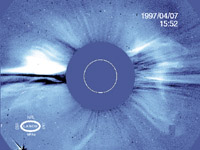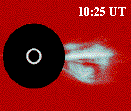 |
Bubble, Bubble, Toil and Trouble While our Sun does give us a steady stream of warmth and light, it also has weather that is turbulent and dynamic, provoking the cosmic equivalent of winds, clouds, waves, precipitation, and storms... |
 |
Hurricane Sol One of the most important solar events from Earth's perspective is the coronal mass ejection (CME), the solar equivalent of a hurricane. A CME is the eruption of a huge bubble of plasma from the SunÝs outer atmosphere, or corona... |
 |
Storm Front Coronal mass ejections occur at a rate of a few times a week to several times per day, depending on how active the Sun may be. And because of the size of the plasma clouds they produce, the odds say Earth is going to get hit by a CME from time to time... |
 |
Seeing the Invisible Auroras are a visible sign of the magnetic mayhem in our atmosphere, but beyond that, the human eye canÝt detect much of what we call space weather... |
 |
Blackouts, Burnouts, and Bummers Aside from bright auroras, there are other less benevolent effects of the connection between Sun and Earth. In fact, bright auroras are merely a visible sign that the balance of electrical and magnetic energy in EarthÝs magnetosphere has been upset... |
 |
Make Your Own Sun-Earth Connections Thanks to the Internet, it is easy for you to keep up with the latest observations and breakthroughs in the study of Sun and Earth... |
 |
Measure the Motion of a Coronal Mass
Ejection Calculate the velocity and acceleration of a coronal mass ejection (CME) based on its position in a series of images from the Large-Angle Spectrometric Coronograph (LASCO) instrument on SOHO... |
 |
NASA Resources for Educators NASA's Central Operation of Resources for Educators (CORE) was established for the national and international distribution of NASA-produced educational materials in audiovisual format... |
Brought to you by the International Solar-Terrestrial Physics Program and NASA.
Comments/Questions/Suggestions: Webmaster
Official NASA Contact: ISTP-Project
/ NASA Home / Goddard Space Flight Center Home /
